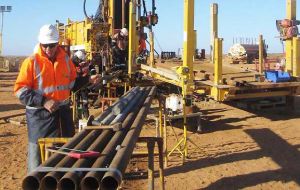MercoPress. South Atlantic News Agency
Mineral rich Australia may contain world's next major oil find
 Arckaringa Basin is estimated to hold anywhere from 3.5 billion to a mind boggling 233 billion barrels of oil.
Arckaringa Basin is estimated to hold anywhere from 3.5 billion to a mind boggling 233 billion barrels of oil. By John C.K. Daly of Oilprice.com - Australia's massive mineral exports allowed it to weather the global recession, which began in 2008, quite nicely.
The U.S. government's Energy Information Administration noted in its country’s analysis for Australia, ”Australia, rich in hydrocarbons and uranium, was the world's second largest coal exporter in 2011 and the third largest liquefied natural gas (LNG) exporter in 2012. Australia is rich in commodities, including fossil fuel and uranium reserves, and is one of the few countries belonging to the Organization for Economic Cooperation and Development (OECD) that is a significant net hydrocarbon exporter, exporting over 70% of its total energy production according to government sources. Australia was the world's second largest coal exporter based on weight in 2011 and the third largest exporter of liquefied natural gas (LNG) in 2012.“
Six months ago Brisbane company Linc Energy Ltd.Energy released two reports, based on drilling and seismic exploration, estimating the amount of shale oil in the as yet untapped 30,000 square mile Arckaringa Basin surrounding Coober Pedy ranging from 3.5 billion to a mind boggling 233 billion barrels of oil.
If the upper end estimates are correct then it means that the Arckaringa Basin is six times larger than the Bakken, seventeen times the size of the Marcellus formation, and 80 times larger than the Eagle Ford U.S. shale deposits.
To put the potential of the Arckaringa Basin in context, Saudi Arabian reserves are estimated at 263 billion barrels.
So, what next for Linc Energy Ltd.? The company has been in discussions to find a partner to develop the Arckaringa Basin after hiring Barclays Plc to help with the process and expects to narrow the talks to one group in a ”few weeks,“ according to Linc Energy Ltd. chief executive officer Peter Bond. Bond added that Linc Energy Ltd.is talking with at least four parties from outside Australia interested in the shale oil project in the Arckaringa Basin.
Linc Energy Ltd. said that the characteristics of its Australian acreage ”compare favourably“ to the prolific Bakken and Eagle Ford shale regions of the US Global energy companies including Chevron, ConocoPhillips, Statoil ASA and BG Group Plc are already making shale investments in Australia.
Australian State Mineral Resources Development Minister Tom Koutsantonis said, ”Shale gas and shale oil will be a key part to securing Australia's energy security now and into the future. We have seen the hugely positive impact shale projects like Bakken and Eagle Ford have had on the U.S. economy. There is still a long way to go, but investment in unconventional liquid projects in South Australia will accelerate as more and more companies such as Linc Energy Ltd.Energy and Altona prove up their resources.“
Natural gas?
Six basins in Australia stretching from coastal Queensland to Western Australia's far northwest contain recoverable shale resources of as much as 437 trillion cubic feet of gas, all of which was previously inaccessible because it is contained in shale formations, which could be unlocked by ”hydraulic fracturing.“ But the U.S. Department of Energy predicts that Australia's shale gas industry will develop at a ”moderate pace“ because the nation's shale oil and gas resources do not as yet have the advanced production infrastructure that has underwritten the U.S. production boom.
And what if estimates for the Arckaringa Basin basin pan out? We'll leave the final word to the EIA, which notes, ”Australia's stable political environment, relatively transparent regulatory structure, substantial hydrocarbon reserves, and proximity to Asian markets make it an attractive place for foreign investment. The government published an Energy White Paper in 2012 that outlines its energy policy including balancing its priority of maintaining energy security with increasing exports to help supply Asia's growing demand for fuel.”
Accordingly, Adelaide had better upgrade its airport to handle all those energy company corporate jets that may well be visiting soon.
Source: Oilprice.com




Top Comments
Disclaimer & comment rules-

-

-

Read all commentsAnd what about the environment? Guess they forgot that part in their reports.
Jul 23rd, 2013 - 04:35 pm 0This is a pretty old story and I'm surprised to see it turning up in MercoPress. Still I laugh at the idea of Coober Pedy turning into a major oil centre - such a tiny little place, and brutally hot in summer. And Tom Koutsantonis will be amused at his description.
Jul 23rd, 2013 - 04:37 pm 0(2) Heisenbergcontext
Jul 23rd, 2013 - 05:11 pm 0Pretty old indeed but still a quite positive story......
Not like this dude's gloom...:
http://www.bloomberg.com/news/2013-06-27/here-s-the-real-crisis-in-australia.html
Anyhow....
Now that you have decided to comment on Federal Aussie matters, I hope you are better prepared for Ozzie Anglolatino's wrath........
He doesn't like any smart comments from the Western Australia Colony ;-)
Commenting for this story is now closed.
If you have a Facebook account, become a fan and comment on our Facebook Page!